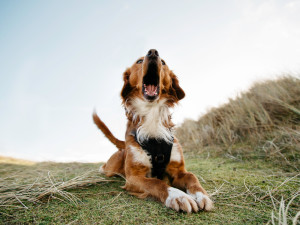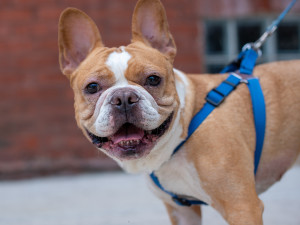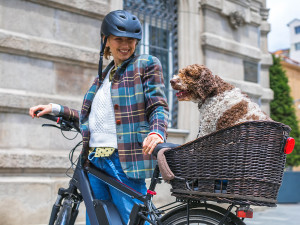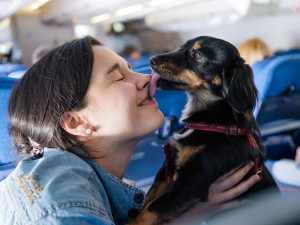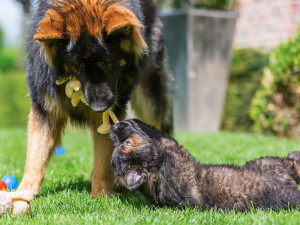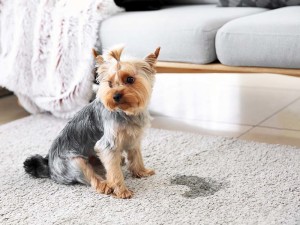“How Can I Curb My Dog’s Squirrel Obsession?“
Dog trainer Robert Haussmann’s pro tips for walking a pup that wants to chase everything that moves
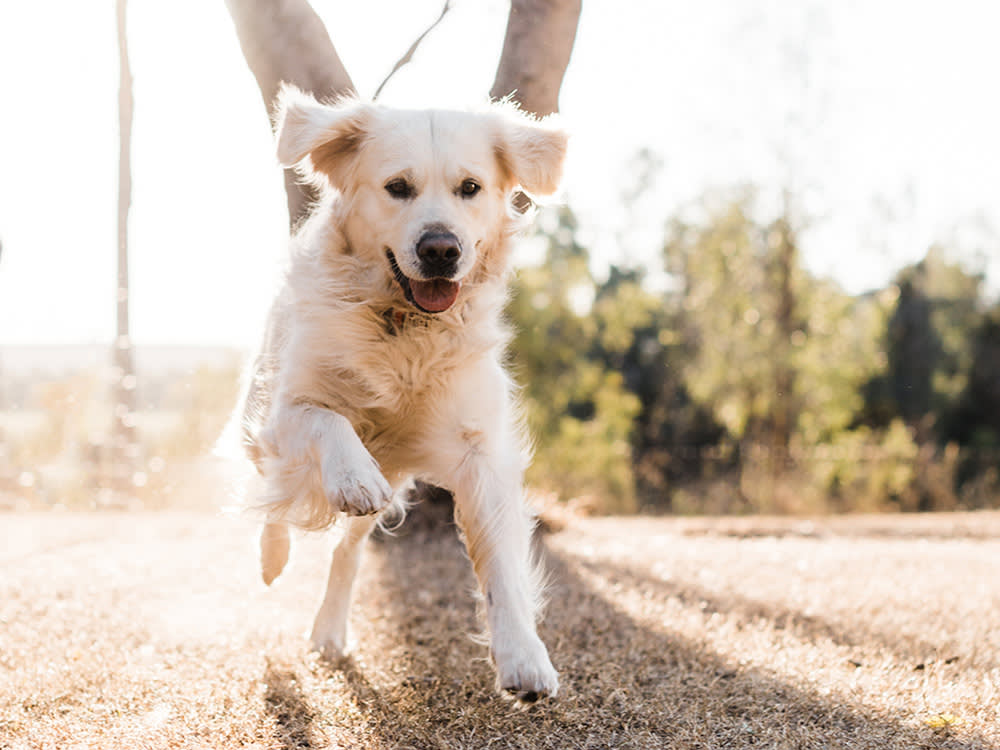
Share Article
Milo, my one year old Lab mix, is very curious and excitable outside with squirrels, people and other dogs. How can I train him to remain calm outside with so many distractions? – Tatyana
Milo sounds like a fun, confident adolescent with enough enthusiasm to go around. I assume when you say “curious and excitable”, you mean pulling on the lead, lurching towards small animals and jumping up on people and dogs. This can make walks unpleasant and social interactions stressful for you as well as those you encounter in your travels. The good news is it sounds like he is brave, smart and excited to meet life head-on, which will serve him well for years to come. Here are some tips to help him stay chilled while doing so.

littleKin™ is Kinship’s home just for puppy and kitten parents. Bop over to check out expert advice, new pet tools, and special deals—all curated for your newest family member.
opens in a new tabFirst, set Milo up for success
Start small and train in a space that has minimal distractions. Training while he is overwhelmed by too many distractions is going to be a non-starter. He will need you to give clear information at a time and place where he can be calm and focused. You can then slowly increase his distractions over time. But you can’t teach him if you can’t get and hold his attention.
I would suggest starting lead trainingopens in a new tab indoors where he can be more focused. Use a mix of medium and high-value rewards to encourage him to stay to one side and stay focused on you. Pick one side of your body to be the dog side. Be sure to keep your body relaxed and the pressure off the lead. Dogs have a reflex to pull against pressure called an oppositional reflex. The more you pull back on his collar or harness, the harder his will pull against it. We are looking for a casual loose lead walk.
Connect rewards with good behaviour
Manage your expectations and focus on small victories. Don’t dangle treats in his face to hold his focus. Instead, keep them up towards your chest to encourage him to look up at you. As you walk and he keeps next to you with a loose lead, mark his good behaviour with a “yes” and reward him with the treat. Using a reward sound such as “yes” helps connect the good behaviour to the reward. Try to keep the reward sound novel so your dog can more easily connect it solely with reward. Words like “good” or “good boy” tend to lose meaning over time because the dog hears it in so many different contexts.
Try not to produce treatsopens in a new tab only to regain his attention when he loses focus. Instead, keep a steady stream of rewards for good behaviour. You can then fade to treats over time as he becomes more and more focused and reliable. During this stage, try to avoid areas and activities that will be overwhelming to him or allow him to engage in the overstimulating behaviours.
Level up his enrichment
I would also increase his environmental enrichment in the home. Feeding him through interactive food dispensing toysopens in a new tab, training games and scent games like “find it” are fun and easy ways to engage him in the mental stimulation that he seems to be craving outside. These activities also give him a chance to practice focusing and seeing you as a source of fun and excitement.
Slowly increase distractions
Once he is able to stay focused on you and keep the lead nice and slack, try bringing him to an area with slightly more distractions such as a garden or quiet street. Repeat the exercise rewarding him for staying focused and keeping a loose lead. Once he is choosing to focus on you, gradually move to more and more distracting locations. Avoid moving too fast. Your goal is to meet Milo where he is at and set him up for the most success. This keeps training fun for you both and encourages him to stay engaged. Everyone likes doing well.
Find the right gear
You may want to explore some other equipment options as well. No pull harnesses can be very effective. These are harnessesopens in a new tab where the lead is attached to a clip in front of the dog’s chest, instead of his back between the shoulder blades. This moves you in front of the dog’s centre of gravity and can provide leverage. Leaning his weight against the lead is less effective and makes it less likely to engage the oppositional reflex.
Be sure you read the harness instructions and size it correctly. Some very determined pullers will lean sideways against the pressure and pull using their shoulders. This can have negative effects on his joints and should be avoided over the long term.
Head collars are also a good option. These go around the muzzle, resembling a horse bridle. When used correctly, these can be very effective in curbing pulling and lunging while being minimally aversive. It will take time to get him comfortable wearing it and you will want to expose him to it slowly while making positive associations over time.
If you just slap it on his face and start walking, he will very probably react poorly and the device can become intrusive and uncomfortable. When the time is taken to desensitise him to the head collar, it can be an incredibly effective anti-pulling tool. Remember, dogs will repeat behaviour that works for them. If pulling works less and focusing on you works more, he will choose to walk calmly by your side.
Counter-condition his prey drive
When it comes to small animals outside, it is likely that you’re working against Milo’s genetic disposition to chase these irresistible creatures. Once you’ve utilised tools and techniques that prevent his lunging and established a solid training routine around distractions, you can start gradual exposure sessions around the chasing behaviours and triggers. This may begin with simply being in a place where he’s seen small animals in the past.
Dogs usually remember trees and hedges frequented by squirrels. If you can get him to work on your walking and training skills without him fixating on the possibility of seeing a squirrel, you’re off to a great start. Practising some basic manners like “leave it, watch me and let’s go” in these areas will improve your experience even more.
Eventually, try to engineer situations where you are a good distance from foraging squirrels and maintain his focus and response to training cues. Expect this to take quite a bit of practice and time. It will require plenty of management; you are probably fighting nature a bit here. You can also practise impulse control around humans and other dogs who are easier to enlist in helping.
Have Milo on the lead as he approaches one of his favourite people. As you approach, praise and reward him for his calm behaviour. Once he begins to pull or jump, you can about face and walk a few feet until he is calm again. This teaches him that a calm approach will gain access to the person and pulling or jumping will lose access. Repeat this until he can approach relatively calmly and say hello. Pairing the presence of other dogs to reward can condition Milo to focus on you when he sees a dog, which can be incredibly useful.
Build your bond and a regular routine
It is important to note that you shouldn’t count on any device to do the training for you. The training comes from you motivating behaviour, limiting his distractions and rewarding his good decisions. Your relationship and bond is the strongest training tool you have and time should be taken to develop that tool above all. Try to think of it as a game you both want to play. I would suggest working on lead skills when he is hungry and you have all the good treatsopens in a new tab. Don’t get discouraged; be patient. Remember you are his teacher and practice makes perfect. You’ll need to work for a while to build a solid routine, especially when he’s so easily overwhelmed by his environment.
Practise regular impulse control exercises
Your training routine should go beyond lead training alone. Manners matter; building a strong foundation of basic cues is just as important. All dogs should be fluent in “sit, stay, lay down, go to your place, drop it and leave it”. Once a basic cue is learnt you can incorporate it in a deference routine – meaning your dog defers to you for things.
Everything Milo wants should be filtered through you and earned using his learned skills. For example, when Milo wants to go outside or come up on the sofa, he should offer a learned behaviour like “sit” or “down” before being invited to have access. This gets him in the habit of pausing and looking to you for guidance. This should be done consistently with positive reinforcement and with no force or ill will.
Another great exercise for impulse control is using “go to your place” and “stay” as part of a relaxation exercise. This is essentially building your dog’s “stay” cue up to a point where you’re adding higher and higher levels of distraction. Having a dog who knows to stay while you take a few steps away is a great start, but having a dog who will stay while you do yoga or answer the door is a truly useful behaviour. It’s a great way to help Milo learn to remain calm while things are happening around him. It also follows a golden rule: teach your dog what they should do, not only what they shouldn’t do.
Find the right help
It’s OK to seek help and find a certified professional dog trainer who practices LIMA (Least Intrusive, Minimally Aversive) techniques. You can search for a trainer by postcode on the Find a Dog Trainer websiteopens in a new tab. A certified trainer with lots of experience should be able to help you sharpen Milo’s skills and offer guidance to manage his impulses. Training will strengthen your bond with Milo and enrich your relationship for many years to come.
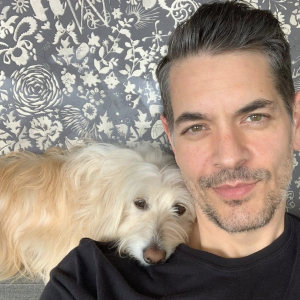
Robert Haussmann, CPDT-KA
Robert Haussman founded Dogboy NYC in 2005 to help pets navigate the urban jungle that is New York City using creative, practical, and humane training methods. Haussmann is a Certified Professional Dog Trainer and Canine Behavior Consultant, specializing in helping dogs overcome behavioral issues including fear, phobias, anxiety, and aggression. He advises owners on the best practices for making their dogs feel safe at home and beyond.
Related articles
![Sad boxer rests on owners lap, dog doesn't want to be touched]() opens in a new tab
opens in a new tabDon’t Ignore These 9 Behavioural Signs That Your Dog Is in Pain
Animal behaviourist Karen B London breaks down the silent ways your pet is trying to tell you they’re hurting
![A young woman standing next to her bike with the dog in the basket]() opens in a new tab
opens in a new tabHow to Take Your Dog on a Bike Ride
So they can feel the wind in their fur
- opens in a new tab
Why Does My Dog Lick Me? The Meaning Behind Dogs Licking Us
The sentiment is nice, but...
![Adult German Shepherd dog plays with a puppy on the lawn]() opens in a new tab
opens in a new tabDog Life Stages: Puppy Adolescence Is Only a Phase
Don’t worry, it’s just a phase!
![French bulldog puppy looking scared at vet]() opens in a new tab
opens in a new tab10 Things to Ask At Your First Vet Visit
There are no stupid questions when it comes to your dog’s health
![dog near pee spot on carpet]() opens in a new tab
opens in a new tabHow to Remove Dog Wee and Other Stains from Carpet – Without Harsh Chemicals
The next time your dog wees on your favourite rug, be prepared with this simple, three-step cleaning method
